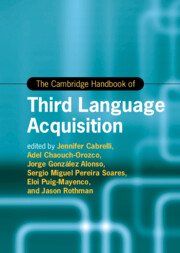Book contents
- The Cambridge Handbook of Third Language Acquisition
- Cambridge Handbooks in Language and Linguistics
- The Cambridge Handbook of Third Language Acquisition
- Copyright page
- Contents
- Figures
- Tables
- Contributors
- Introduction Multilingualism
- Part I Theoretical Approaches to L3/Ln
- Part II L3/Ln across Linguistic Domains
- Part III Becoming and Staying Multilingual at Different Ages
- Part IV L3/Ln in Action
- 16 Theoretical Linguistic Approaches to Multilingual Code-Switching
- 17 Psycholinguistics of Multilingual Code-Switching
- 18 Third Language Acquisition in the Classroom
- 19 Diversity in Multilingual Learners
- Part V L3/Ln and Cognition
- Part VI Research Methods in L3/Ln
- Index
- References
17 - Psycholinguistics of Multilingual Code-Switching
from Part IV - L3/Ln in Action
Published online by Cambridge University Press: 13 July 2023
- The Cambridge Handbook of Third Language Acquisition
- Cambridge Handbooks in Language and Linguistics
- The Cambridge Handbook of Third Language Acquisition
- Copyright page
- Contents
- Figures
- Tables
- Contributors
- Introduction Multilingualism
- Part I Theoretical Approaches to L3/Ln
- Part II L3/Ln across Linguistic Domains
- Part III Becoming and Staying Multilingual at Different Ages
- Part IV L3/Ln in Action
- 16 Theoretical Linguistic Approaches to Multilingual Code-Switching
- 17 Psycholinguistics of Multilingual Code-Switching
- 18 Third Language Acquisition in the Classroom
- 19 Diversity in Multilingual Learners
- Part V L3/Ln and Cognition
- Part VI Research Methods in L3/Ln
- Index
- References
Summary
Code-switching is the fluid alternation between languages in text or during speech. Despite its ubiquity within multilingual communities, the processing of code-switches is associated with processing costs. Recent research attempts to reconcile this apparent contradiction by investigating how linguistic, cognitive, social, and experiential factors attenuate or modify potential switch costs in comprehension. This complex interaction of factors is incorporated into recent experience-based models of bilingualism such as the Adaptive Control hypothesis (Green & Abutalebi, 2013). In this chapter we review this literature, which is based primarily on bilingual speakers, and highlight instances where lab-based studies on multilingual code-switching can provide significant theoretical contributions. We summarize three recent studies on Algerian multilinguals that illustrate how these factors extend to multilingual scenarios and conclude with a special emphasis on the social context of multilingual communities as a critical foundation for future experimental studies on multilingual code-switching.
- Type
- Chapter
- Information
- The Cambridge Handbook of Third Language Acquisition , pp. 437 - 465Publisher: Cambridge University PressPrint publication year: 2023

